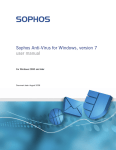Download Operating Instructions Safety Switch CET.-AS-...-CB
Transcript
Operating Instructions Safety Switch CET.-AS-...-CB-... (Multicode) More than safety. Operating Instructions Safety Switch CET.-AS-...-CB-... Contents Correct use Possible combinations for CET components 3 4 Exclusion of liability and warranty 4 General safety instructions 5 Function6 Function of the electronics 6 Function of the guard locking 8 Mechanical release and mechanical key release (can be retrofitted) 10 Emergency unlocking (can be retrofitted) 11 Lockout mechanism (optional) 12 Changing the approach direction 13 Mounting14 Electrical connection Setting the AS-Interface address Control of the guard locking Configuration in the AS-Interface safety monitor AS-Interface status messages 16 16 16 17 18 Setup19 LED indicators 19 Initial setup 19 Functional check 20 System status table 21 Technical data 22 Technical data for safety switch CET.-AS-...-CB-...22 Dimension drawing safety switch CET.-AS 24 Technical data actuator CET-A-BWK-50X 26 Accessories27 Inspection and service 28 Service28 Declaration of conformity 29 2 Operating Instructions Safety Switch CET.-AS-...-CB-... Correct use The safety switch CET.-AS is operated as a slave on the safety bus AS-Interface Safety at Work and functions as an electromagnetic interlock device with guard locking. In combination with a safety guard and the machine control, this safety component prevents the safety guard from being opened while a dangerous machine movement is being performed. For the control system, this means that ÌÌstarting commands which cause hazardous situations must become active only when the safety guard is in protective position and the guard locking is in locked position. The locked position of the guard locking must be released only when the hazardous situation is no longer present. Before safety components are used, a risk assessment must be performed on the machine, e.g., in accordance with ÌÌEN ISO 13849-1, Safety of machinery. Safety related parts of control systems. General principles for design, Annex B ÌÌEN ISO 12100, Safety of machinery – General principles for design – Risk assessment and risk reduction. ÌÌIEC 62061, Safety of machinery. Functional safety of safety-related electrical, electronic and programmable electronic control systems. Correct use includes compliance with the relevant requirements for installation and operation, in particular ÌÌEN ISO 13849, Safety of machinery. Safety related parts of control systems. General principles for design ÌÌEN 1088, Safety of machinery. Interlocking devices associated with guards. Principles for design and selection ÌÌEN 60204-1, Safety of machinery. Electrical equipment of machines. General requirements. The safety switch must be used only in conjunction with the designated CET actuator from EUCHNER. On the use of different actuators, EUCHNER provides no warranty for safe function. Important: ÌÌThe user is responsible for the integration of the device into a safe overall system. For this purpose, the overall system must be validated, e.g. in accordance with EN ISO 13849-2. ÌÌCorrect use requires observing the permissible operating parameters (see section Technical data page 22). ÌÌIf a product data sheet is included with the product, the information on the data sheet applies in case of discrepancies with the operating instructions. ÌÌIn the estimation of the PL for the overall system, a maximum value of 100 years can be assumed for the MTTFd according to the limit value in EN ISO 13849‑1:2008, section 4.5.2. This corresponds to a minimum value for the PFHd of 2.47 x 10-8/h. ÌÌIf the simplified method according to section 6.3 EN ISO 13849:2008-12 is used for validation, the Performance Level (PL) may be reduced if several devices are connected one after the other. ÌÌIt is only allowed to use components that are permissible in accordance with the table below. 3 Operating Instructions Safety Switch CET.-AS-...-CB-... Possible combinations for CET components Actuator Safety switch CET-A-BWK-50X 096327 CET.-AS-...-CB-... Key to symbols Combination possible Exclusion of liability and warranty In case of failure to comply with the conditions for correct use stated above, or if the safety instructions are not followed, or if any servicing is not performed as required, liability will be excluded and the warranty void. 4 Operating Instructions Safety Switch CET.-AS-...-CB-... General safety instructions As the unique actuator codes are not evaluated, the CET.-AS-...-CB-... version can only be used for applications in which a hazard cannot result from possible tampering with the system. Safety switches fulfill personal protection functions. Incorrect installation or tampering can lead to fatal injuries to personnel. Check the safe function of the safety guard particularly ÌÌafter any setup work ÌÌafter the replacement of a CET component ÌÌafter an extended period without use ÌÌafter every fault Independent of these checks, the safe function of the safety guard should be checked at suitable intervals as part of the maintenance schedule. Warning! Danger of fatal injury in the event of incorrect connection or incorrect use. ÌÌSafety switches must not be bypassed (bridging of contacts), turned away, removed or otherwise rendered ineffective. On this topic pay attention in particular to the measures for reducing the possibility of bypassing from EN 1088:1995+A2:2008, section 5.7. The device is only allowed to be installed and placed in operation by authorized personnel ÌÌwho are familiar with the correct handling of safety components ÌÌwho are familiar with the applicable EMC regulations ÌÌwho are familiar with the applicable regulations on health and safety and accident prevention ÌÌwho have read and understood the operating instructions.l Important: Prior to use, read the operating instructions and keep it in a safe place. Ensure the operating instructions is always available during mounting, setup and servicing. EUCHNER cannot provide any warranty in relation to the readability of the CD for the storage period required. For this reason you should archive a printed copy of the operating instructions. If you should lose the operating instructions, you can download this documents from www. EUCHNER.de. 5 Operating Instructions Safety Switch CET.-AS-...-CB-... Function Function of the electronics Lift tappet Safety switches series CET.-AS permit locking of movable safety guards. They meet the following safety requirements: ÌÌCategory 3, PLe according to EN ISO 13849-1 (mounting head upward) ÌÌCategory 4, PLe according to EN ISO 13849-1 (mounting head downward or horizontal) The non-contact safety switch CET.-AS consists of three components: coded actuator (transponder), evaluation unit and read head. The evaluation unit is integrated into the switch housing with the read head. Recess Each actuator possesses a unique electronic coding and so is a unique element in the system used. The code in an actuator cannot be reprogrammed. Slide Transponder Springmounted guard locking pin Unlike systems with unique code detection, on multicode devices a specific code is not requested but instead it is only checked whether the actuator is of a type that can be detected by the system (multicode detection). There is no exact comparison of the actuator code with the code defined in the safety switch (unique code detection). The safety switch with integrated evaluation unit and read head is fastened to the fixed part of the safety guard. The actuator attached to the movable part of the safety guard is moved towards the read head fitted in the safety switch by closing the door. When the switch-on distance is reached, power is supplied to the actuator by the inductive read head and data can be transferred. If the actuator is above the extended lift tappet, the door is closed and the halfsequence is sent via the AS-Interface bus (state: safety guard closed, guard locking not active). The code sequence is sent via the AS-Interface bus when the actuator is inserted into the recess (state: safety guard closed, guard locking active). The bit sequence 0000 is sent via the AS-Interface bus when the safety guard is opened. 6 Operating Instructions Safety Switch CET.-AS-...-CB-... Status table Programming State Safety guard closed, guard locking active Dual-channel conditionally dependent Dual-channel independent D0, D1 Monitor diagnosis Green Guard locking open Halfsequence 00 Yellow flashing Invalid state (safety guard open, guard locking active) 00 Halfsequence Red flashing (monitoring of the invalid state) Safety guard open 00 00 Red Address 0 or communication disrupted – Gray Safety guard closed, guard locking active Code sequence Green Guard locking open Halfsequence 00 Red Invalid state (safety guard open, guard locking active) 00 Halfsequence Red (monitoring of the invalid state) Safety guard open 00 00 Red Address 0 or communication disrupted Safety guard closed, guard locking active Dual-channel dependent Synchronization time infinite ∞ D2, D3 Code sequence – Gray Code sequence Green if safety guard was previously open or yellow flashing after startup if only the guard locking was open. Halfsequence 00 Yellow flashing if safety guard was previously closed. Red if safety guard was previously open. Invalid state (safety guard open, guard locking active) 00 Halfsequence Yellow flashing if safety guard was previously closed. Red if safety guard was previously open. Safety guard open 00 00 Red Guard locking open Address 0 or communication disrupted 7 – Gray Operating Instructions Safety Switch CET.-AS-...-CB-... Function of the guard locking Version CET3-AS, guard locking by spring force with door monitoring output The lift tappet is pressed into the locked position by the force of the spring for the guard locking pin in the actuator and unlocked electromagnetically by the safety switch. The guard locking solenoid is switched by software via AS-Interface output bit D0. The guard locking functions in accordance with the closed-circuit current principle. The guard locking cannot be opened directly if the guard locking solenoid is switched off by means of AS-Interface output bit D0. The door can be opened directly if the guard locking solenoid is switched on by means of AS-Interface output bit D0. Closing safety guard and activating guard locking The lift tappet is pushed down by the actuator. The door monitoring contact and the solenoid monitoring contact are closed. The complete safety code sequence is sent via AS-Interface input bits D0 to D3. Deactivating guard locking Switching the guard locking solenoid off via AS-Interface output bit D0 extends the lift tappet and raises the actuator's guard locking pin over the edge of the recess. The half-sequence is sent via AS-Interface input bits D0 and D1 in every bus cycle. Opening safety guard Opening the safety door moves the actuator out of the operating distance. The values 0, 0, 0, 0 are continuously sent via AS-Interface input bits D0 to D3. Version CET4-AS, guard locking by solenoid force with door monitoring output Important: The safety guard can be opened immediately in the event of interruption of the solenoid power supply! Usage only in special cases in accordance with strict evaluation of the accident risk (see DIN EN 1088 (1995), section 5.5)! Example: If the risk of accidental locking inside a safety guard during a power failure is higher than the risk of ineffective guard locking. The guard locking operates in accordance with the open-circuit current principle. The lift tappet is held in locked position by electromagnetic force and released by spring force. The guard locking solenoid is switched by software via AS-Interface output bit D0. 8 Operating Instructions Safety Switch CET.-AS-...-CB-... Closing safety guard and activating guard locking The safety door can be opened as long as the lift tappet is held in the extended position. Switching the guard locking solenoid on via AS-Interface output bit D0 releases the lift tappet. The actuator's guard locking pin can now press the lift tappet down. The safety door is locked and the solenoid monitoring contact is closed as soon as the guard locking pin is fully inserted into the recess. The complete safety code sequence is sent via AS-Interface input bits D0 to D3. Deactivating guard locking Switching the guard locking solenoid off via AS-Interface output bit D0 extends the lift tappet and raises the actuator's guard locking pin over the edge of the recess. The half-sequence is sent via AS-Interface input bits D0 and D1 in every bus cycle. Opening safety guard Opening the safety door moves the actuator out of the operating distance. The values 0, 0, 0, 0 are continuously sent via AS-Interface input bits D0 to D3. 9 Operating Instructions Safety Switch CET.-AS-...-CB-... Mechanical release and mechanical key release (can be retrofitted) Important: ÌÌThe mechanical release is not a safety function. ÌÌThe machine manufacturer must select and use a suitable release (escape re- 35,5 Ø 20 lease, emergency unlocking, etc.) for a specific application. A risk assessment appraisal is required for this purpose. It may be necessary to take specifications from a product standard into account. 5,8 ÌÌThe mechanical key release must not be used to lock the switch during maintenance work to prevent activation of guard locking, for example. ÌÌThe correct function must be checked at regular intervals. ÌÌLoss of the release function due to mounting errors or damage during mounting. ÌÌCheck the release function every time after mounting. ÌÌLoss of the release function due to tension on the actuator. The door must not 16,7 be30under tension during release. ÌÌPlease observe the notes on any enclosed data sheets. The mechanical release can be used to unlock guard locking, irrespective of the state of the solenoid. Using mechanical release 1. Unscrew locking screw 2. Using a screwdriver, turn the mechanical release by around 180° in the direction of the arrow The lift tappet is extended and raises the actuator's guard locking pin over the edge of the recess. The half-sequence is sent via AS-Interface input bits D0 and D1 in every bus cycle. ¨¨ The safety device can be opened The mechanical release must be returned to its original position and sealed after use (for example with sealing lacquer). Using mechanical key release On devices with mechanical key release (can be retrofitted), simply turn the key to unlock. For mounting, see the mechanical key release supplement. The lift tappet is extended and raises the actuator's guard locking pin over the edge of the recess. The half-sequence is sent via AS-Interface input bits D0 and D1 in every bus cycle. 10 Operating Instructions Safety Switch CET.-AS-...-CB-... Emergency unlocking (can be retrofitted) Important: ÌÌEmergency unlocking is not a safety function. ÌÌThe machine manufacturer must select and use a suitable release (escape release, emergency unlocking, etc.) for a specific application. A risk assessment appraisal is required for this purpose. It may be necessary to take specifications from a product standard into account. ÌÌThe correct function must be checked at regular intervals. ÌÌLoss of the release function due to mounting errors or damage during mounting. ÌÌCheck the release function every time after mounting. ÌÌLoss of the release function due to tension on the actuator. The door must not be under tension during release. ÌÌPlease observe the notes on any enclosed data sheets. Emergency unlocking can be used to unlock guard locking, irrespective of the state of the solenoid. For mounting, see the mounting supplement. Using emergency unlocking Important: The door must not be under tension when emergency unlocking is actuated. ÌÌTurn emergency unlocking clockwise until it clicks into place. Detent bolt The lift tappet is extended and raises the actuator's guard locking pin over the edge of the recess. The half-sequence is sent via AS-Interface input bits D0 and D1 in every bus cycle. ¨¨ The safety device can be opened To reset, press the detent bolt inward using a small screwdriver or similar tool and turn the emergency unlocking back. 71 11 Operating Instructions Safety Switch CET.-AS-...-CB-... Lockout mechanism (optional) Important: ÌÌThe lockout mechanism is not a safety function. ÌÌThe correct function must be checked at regular intervals. The lockout mechanism can be used to prevent maintenance personnel from being unintentionally locked in the danger area, for example. In locked position, the lockout mechanism prevents activation of guard locking. The lockout mechanism can be secured in locking position with up to three locks. The mechanical release can still be used. Using the lockout mechanism Important: Deactivate guard locking and open the safety door before using the lockout mechanism. Before entering the danger area: 1. Open the door 2. Press button, move lockout mechanism to locking position (Figures A and B) and secure with lock (Figure C) ¨¨ Guard locking cannot be activated, and it must not be possible to start the machine. Important: Test this before entering the danger area. Resetting the lockout mechanism: 1. Open the safety door if necessary 2. Remove the lock 3. Move lockout mechanism to basic position (Figure A) Locking function not active Pushbutton Figure A Locking function active Push button and align lever Figure B 12 Locking function active and secured Fit lock Figure C Operating Instructions Safety Switch CET.-AS-...-CB-... Using mechanical release 1. Unscrew locking screw 2. Operate the mechanical release through the threaded bore of the locking screw (e.g. with a metal rod ∅ 3 mm) (1) The lift tappet is extended and raises the actuator's guard locking pin over the edge of the recess. The half-sequence is sent via AS-Interface input bits D0 and D1 in every bus cycle. ¨¨ The safety device can be opened The locking screw must be screwed back in and sealed after use (for example with sealing lacquer). (2) Changing the approach direction 1. Remove the screws from the safety switch 2. Set the required direction 3. Tighten the screws with a torque of 1.5 Nm. Figure 1: Changing the approach direction 13 Operating Instructions Safety Switch CET.-AS-...-CB-... Mounting Caution! Safety switches must not be bypassed (bridging of contacts), turned away, removed or otherwise rendered ineffective. ÌÌOn this topic pay attention in particular to the measures for reducing the possibility of bypassing according to EN 1088:1995.A2:2008, Sec. 5.7. ÌÌThe max. achievable category according to EN 13849-1 depends on the installation position (seeTechnical data page 22). Caution! Risk of damage to equipment as a result of incorrect installation. ÌÌSafety switches must not be used as a mechanical end stop. Fit an additional end stop for the movable part of the safety guard. ÌÌObserve the min. door radii (see figure below). ÌÌEnsure that the actuator contacts the slide in the designated area (see figure below). Marks on the slide specify the prescribed approach zone. ÌÌThe prerequisite for trouble-free long-term operation is protection of the switch head and the actuator against penetrating foreign objects such as swarf, sand, and blasting shot, etc. The switch should be installed with the actuating head down for this purpose. ÌÌCover the switch and the actuator during painting work. min min R30 0 74,5 ± 4 mm 0 R80 Anfahrbereich/ Approach Zone Figure 2: Door radii and approach zone 14 Operating Instructions Safety Switch CET.-AS-...-CB-... Note the following points: ÌÌActuator and safety switch must be easily accessible for inspection and replacement. ÌÌThe switching operation must only be triggered by the specific actuator designated for this purpose. ! = 90° ÌÌActuator and safety switch must be fitted so that ÌÌthe actuator is positively mounted on the safety guard, e.g. by using the safety screws included. ÌÌthey cannot be removed or tampered with using simple means. ÌÌthe active faces of the actuator and the safety switch are parallel to each other (see figure on the left). ÌÌthe actuator is fully inserted into the switch recess when the safety guard is closed (see figure on the left). ÌÌno dirt can accumulate in the recess. ! 15 Operating Instructions Safety Switch CET.-AS-...-CB-... Electrical connection Important: The devices are tested according to the requirements of UL508. (UL), an isolating transforFor use and operation as per the requirements of mer or a power supply with secondary overcurrent protection (3 A) must be used: ÌÌElectrically isolated power supply unit with a max. open-circuit voltage of 33.3 V/ DC and a limited current of max. 8 A. or ÌÌElectrically isolated power supply unit in combination with fuse as per UL248. This fuse should be designed for max. 3 A and should be integrated into the 33.3 V/DC voltage section. 1 2 3 4 AS-Interface + Auxiliary power 0 V AS-Interface Auxiliary power 24 V View of safety switch plug connector 4 3 1 2 Figure 3: AS-Interface M12 plug connector terminal assignment Setting the AS-Interface address The address can be set prior to or after assembly. The AS-Interface address of the safety switch is set using an AS-Interface programming device. Addresses 1 to 31 are valid. The unit is programmed by connecting the programming device to the M12 plug connector on the safety switch with an AS-Interface programming device. Address 0 is the default setting on delivery (the AS-Interface LED flashes alternately red/yellow during operation). Control of the guard locking The guard locking is opened and closed using the output D0. When the guard locking is open, the safety circuit shuts down. Observe the following if the guard locking solenoid on a CET3-AS spring interlock safety switch in the operating mode door locking for duration of the time-delay is switched on (unlocked) via the second release contact of a dual-channel safety monitor and a PLC: ÌÌIt is not possible to switch off the guard locking solenoid by means of the moni- tor alone. The control system (PLC) must therefore switch off the guard locking solenoid in locked position via AS-Interface output D0 = 0 in order to re-establish the switch-on conditions for the first OSSD. ÌÌThe AS-Interface output must be switched on with D0 = 1 so that the guard locking solenoid can be unlocked by the second safety output of the monitor. 16 Operating Instructions Safety Switch CET.-AS-...-CB-... Configuration in the AS-Interface safety monitor (see operating instructions for the AS-Interface safety monitor) Dual-channel dependent Cat. 4 The safety switch is configured in the AS-Interface safety monitor with the ASInterface address set as follows, for example: ÌÌdual-channel dependent ÌÌwith or without start-up test ÌÌSynchronization time = infinite In this mode, the safety guard must be opened each time prior to restarting. Dual-channel conditionally dependent Cat. 4 The safety switch is configured in the AS-Interface safety monitor with the ASInterface address set as follows, for example: ÌÌdual-channel conditionally dependent ÌÌindependent: In-1 Important: The switch is monitored for a malfunction; the door message must not switch before guard lock monitoring. The safety guard does not have to be opened in this operating mode. Safety is provided again when the guard locking is closed. Dual-channel independent Cat. 1 The safety switch is configured in the AS-Interface safety monitor with the ASInterface address set as follows, for example: ÌÌdual-channel independent ÌÌwith or without start-up test Important: Failure of a signal or function is not detected in this operating mode. The safety guard does not have to be opened in this operating mode. Safety is provided again when the guard locking is closed. 17 Operating Instructions Safety Switch CET.-AS-...-CB-... AS-Interface status messages A dual LED (red/green) displays the colors red, green and yellow. The following table provides assistance with troubleshooting. State LED ASI green Explanation Normal operation red No data exchange between master and slave Cause: - Master in STOP mode - Slave not in LPS - Slave with wrong IO/ID red/yellow alternately flashing No data exchange between master and slave Cause: slave address = 0 red/green alternately flashing red flashing Auxiliary power not connected or device fault in the slave. Contact EUCHNER. Two additional function LEDs may be activated via the AS-Interface bus, e.g. to display the door status. The LEDs are connected as an output to the AS-Interface bus via bits D1 and D2. 18 Operating Instructions Safety Switch CET.-AS-...-CB-... Setup LED indicators LED LED 2 OUT D (grün/green) ASI (grün/rot green/red) LED1 / (rot/red) STATE Color State illuminated green flashing STATE (grün/rot green/red) *) Significance Normal operation (further signal functions see System status table page 21) ASi red/green Status messages see chapter AS-Interface status messages page 18 STATE red illuminated LED 1 red freely configurable* LED 2 green freely configurable* Internal electronics fault Can vary depending on version. See data sheet. Initial setup 1. Apply operating voltage to the safety switch. ¨¨ The green LED flashes cyclically one time and signals that it is in standby state. 2. Move actuator to the read head (observe distance < Sao). ¨¨ The green LED illuminates continuously and indicates the detection of the actuator. 19 Operating Instructions Safety Switch CET.-AS-...-CB-... Functional check Warning! Danger of fatal injury as a result of faults in installation and functional check. ÌÌBefore carrying out the functional check, make sure that there are no persons in the danger area. ÌÌObserve the valid accident prevention regulations. Mechanical function test The actuator must slide easily into the recess on the actuating head. Close the safety guard several times to check the function. Electrical function test After installation and any fault, the safety function must be fully checked. Proceed as follows: 1. Switch on operating voltage. ¨¨ The machine must not start automatically. 2. Close all safety guards. Guard locking by solenoid force: Activate guard locking. ¨¨ The machine must not start automatically. It must not be possible to open the safety guard ¨¨ The STATE LED illuminates continuously in green. 3. Enable operation in the control system. ¨¨ It must not be possible to deactivate the guard locking as long as operation is enabled. 4. Disable operation in the control system and deactivate guard locking. ¨¨ The safety guard must remain locked until there is no longer any risk of injury. ¨¨ It must not be possible to start the machine as long as the guard locking is deactivated. Repeat steps 2-4 for each safety guard. 20 Operating Instructions Safety Switch CET.-AS-...-CB-... LED indicator output STATE (red) STATE (green) Operating mode Actuator/door position System status table closed Normal operation State Normal operation, door closed and locked closed 1x Normal operation, door closed and not locked open 1x Normal operation, door open X 5x Internal fault (e.g. component faulty, data error) X X X Internal fault LED not illuminated LED illuminated Key to symbols 10 Hz (8 s) 3x X LED flashes for 8 seconds at 10 Hz LED flashes three times Any state After the cause has been remedied, faults can generally be reset by opening and closing the door. If the fault is still displayed afterward, use the reset function or briefly interrupt the power supply. Please contact the manufacturer if the fault could not be reset after restarting. Important: If you do not find the displayed device status in the System status table, this indicates an internal device fault. In this case, you should contact the manufacturer. 21 Operating Instructions Safety Switch CET.-AS-...-CB-... Technical data Note: If a product data sheet is included with the product, the information on the data sheet applies in case of discrepancies with the operating instructions. Technical data for safety switch CET.-AS-...-CB-... Parameter Value min. typ. max. Unit General Material, slide Stainless steel Material, safety switch housing Die-cast aluminum Installation position Any (recommendation: switch head downward) Degree of protection IP 67 Actuator approach speed, max. 20 Locking force Fmax Locking force FZh in acc. with GS-ET-19 N FZh = Fmax/1.3 = 5,000 N Weight Degrees of freedom (actuator in recess) X, Y, Z Connection type (depending on version) m/min 6,500 Approx. 1.0 kg X, Y ± 5; Z ± 4 mm Plug connector M12, 4-pin Auxiliary voltage 24 -10%/+15% V DC Current consumption 50 mA Current consumption solenoid ICM 400 mA Classification acc. to EN IEC 60947-5-3 PDF-M AS-Interface data Total current consumption EA code: 7 ID code: B - - Valid AS-Interface addresses 30 mA 1 - 31 AS-Interface inputs Acc. to AS-Interface Safety at Work Door monitoring contact D0, D1 Solenoid monitoring contact D2, D3 AS-Interface outputs Guard locking solenoid D0, 1 = solenoid energized Red LED D1, 1 = LED on Green LED Reliability values according to EN ISO 13849-1 D2, 1 = LED on Head downward or horizontal Head upward Category 4 3 Performance Level (PL) e e 3.1 x 10 -9 / h 4.29 x 10 -8 / h 20 20 PFHd Mission time 22 years Operating Instructions Safety Switch CET.-AS-...-CB-... Typical system times Switch-on time of safety outputs: The max. reaction time from the moment when the safety guard is locked to the moment when the safety outputs switch on Ton is 400 ms. Risk time according to EN 60947-5-3: If an actuator moves outside the operating distance, transmission of the code sequence on the corresponding safety switch is deactivated after a maximum of 500 ms. 23 Operating Instructions Safety Switch CET.-AS-...-CB-... Dimension drawing safety switch CET.-AS 41 M12 15 42 30 LED1 / (rot/red) STATE (grün/rot green/red) ASI (grün/rot green/red) Mechanical release <15> 15 66,7 90,2 5 74,5 ±4 18,5 167 130 LED 2 OUT D (grün/green) 43,6 52 11 6,5 für Schraube M6/for screw M6 ISO1207 / ISO4762 25 22 25 21,7 34 Lift tappet 24 Operating Instructions Safety Switch CET.-AS-...-CB-... With mechanical key release With emergency unlocking With front wire release 30,4 25 35,5 83 71 16,7 With lockout mechanism 42 140 30 30,5 Ø 20 5,8 85 25 Operating Instructions Safety Switch CET.-AS-...-CB-... Technical data actuator CET-A-BWK-50X Parameter Value min. Unit typ. Housing material max. Stainless steel Stroke max. Weight Ambient temperature - 20 15 mm 0.25 kg - Degree of protection acc. to EN IEC 60529 + 55 IP 67 1 x 106 operating cycles Mechanical life Locking force, max. 6,500 Installation position Active face opposite switch head Power supply N Inductive via switch Dwell time 1) 1) °C 0.5 - - s The dwell time is the time that the actuator must be inside or outside the operating distance. Dimension drawing actuator CET-A-BWK-50X 6,5 22 8,5 5 34 45 34 15 Active face 8 6,5 5 15 16 15 71 Tip! Safety screws are included with the actuator. 26 5 15 16 38 Operating Instructions Safety Switch CET.-AS-...-CB-... Accessories Designation Use Version Mechanical key release for safety switch CET identical locking, incl. 2 keys Replacement key for mechanical key release, identical locking 2 keys, identical locking Emergency unlocking for safety switch CET latching in both positions Cover for safety switch CET and actuator CET Mounting plate EMP-L-CET for safety switch CET 106695 EMP-L-CET Mounting plate EMP-B-CET for actuator CET 106694 EMP-B-CET Actuator for safety switch CET incl. safety screws 096327 CET-A-BWK-50X Safety screws (spare) for actuator CET 4 x M5 x 16 packaging unit: 100 ea. 073456 M5 x 16 door hinge right door hinge left 27 Order No./item 098850 Mechanical key release 099434 Replacement key 103714 Emergency unlocking CET 098808 CET cover right 098807 CET cover left Operating Instructions Safety Switch CET.-AS-...-CB-... Inspection and service Warning! Loss of the safety function because of damage to the system. In case of damage, the entire device must be replaced. Only accessories or spare parts that can be ordered from EUCHNER may be replaced. Regular inspection of the following is necessary to ensure trouble-free long-term operation: ÌÌCheck the switching function (see section Functional check page 20) ÌÌCheck all additional functions (e.g. escape release, lockout mechanism, etc.) ÌÌCheck the secure fastening of the devices and the connections ÌÌCheck for soiling No servicing is required, repairs to the device are only allowed to be made by the manufacturer. Note: The year of manufacture can be seen in the lower right corner of the rating plate. The current version number in the format (VX.X.X) can also be found on the device. Service If service support is required, please contact: EUCHNER GmbH + Co. KG Kohlhammerstraße 16 D-70771 Leinfelden-Echterdingen Service telephone: +49 711 7597-500 E-mail: [email protected] Internet: www.euchner.de 28 Operating Instructions Safety Switch CET.-AS-...-CB-... Declaration of conformity 29 Euchner GmbH + Co. KG Kohlhammerstraße 16 D-70771 Leinfelden-Echterdingen [email protected] www.euchner.de Edition: 112685-04-10/13 Title: Operating Instructions Safety Switch CET.-AS-...-CB-... (translation of the original operating instructions) Copyright: © EUCHNER GmbH + Co. KG, 10/2013 Subject to technical modifications, no responsibility is accepted for the accuracy of this information. More than safety.

















































